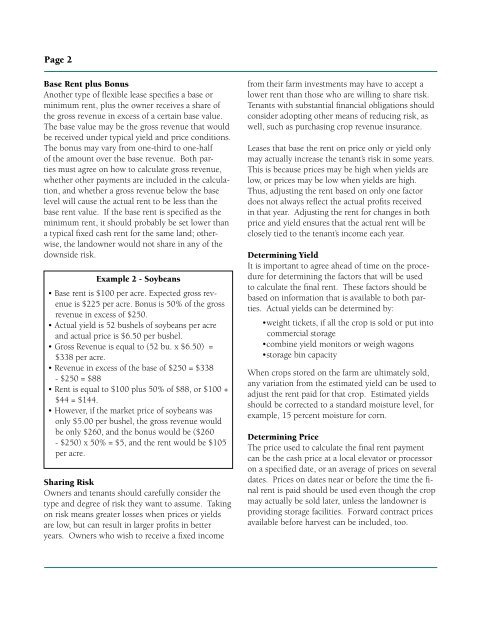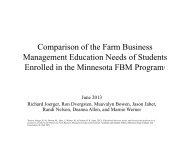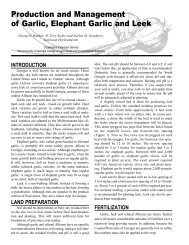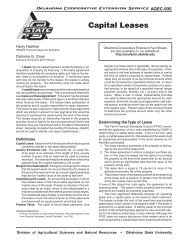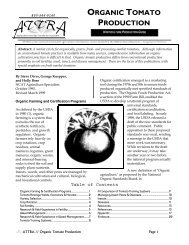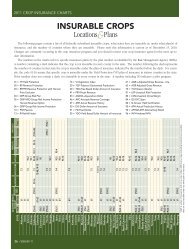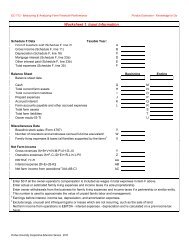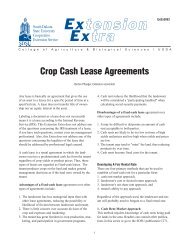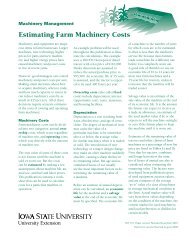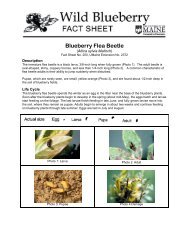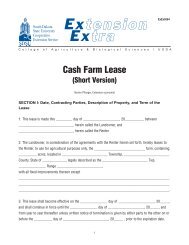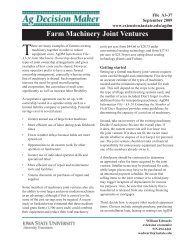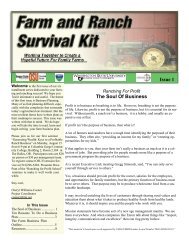Flexible Farm Lease Agreements - National Ag Risk Education Library
Flexible Farm Lease Agreements - National Ag Risk Education Library
Flexible Farm Lease Agreements - National Ag Risk Education Library
You also want an ePaper? Increase the reach of your titles
YUMPU automatically turns print PDFs into web optimized ePapers that Google loves.
Page <br />
Base Rent plus Bonus<br />
Another type of flexible lease specifies a base or<br />
minimum rent, plus the owner receives a share of<br />
the gross revenue in excess of a certain base value.<br />
The base value may be the gross revenue that would<br />
be received under typical yield and price conditions.<br />
The bonus may vary from one-third to one-half<br />
of the amount over the base revenue. Both parties<br />
must agree on how to calculate gross revenue,<br />
whether other payments are included in the calculation,<br />
and whether a gross revenue below the base<br />
level will cause the actual rent to be less than the<br />
base rent value. If the base rent is specified as the<br />
minimum rent, it should probably be set lower than<br />
a typical fixed cash rent for the same land; otherwise,<br />
the landowner would not share in any of the<br />
downside risk.<br />
Example 2 - Soybeans<br />
• Base rent is $100 per acre. Expected gross revenue<br />
is $225 per acre. Bonus is 50% of the gross<br />
revenue in excess of $250.<br />
• Actual yield is 52 bushels of soybeans per acre<br />
and actual price is $6.50 per bushel.<br />
• Gross Revenue is equal to (52 bu. x $6.50) =<br />
$338 per acre.<br />
• Revenue in excess of the base of $250 = $338<br />
- $250 = $88<br />
• Rent is equal to $100 plus 50% of $88, or $100 +<br />
$44 = $144.<br />
• However, if the market price of soybeans was<br />
only $5.00 per bushel, the gross revenue would<br />
be only $260, and the bonus would be ($260<br />
- $250) x 50% = $5, and the rent would be $105<br />
per acre.<br />
Sharing <strong>Risk</strong><br />
Owners and tenants should carefully consider the<br />
type and degree of risk they want to assume. Taking<br />
on risk means greater losses when prices or yields<br />
are low, but can result in larger profits in better<br />
years. Owners who wish to receive a fixed income<br />
from their farm investments may have to accept a<br />
lower rent than those who are willing to share risk.<br />
Tenants with substantial financial obligations should<br />
consider adopting other means of reducing risk, as<br />
well, such as purchasing crop revenue insurance.<br />
<strong>Lease</strong>s that base the rent on price only or yield only<br />
may actually increase the tenant’s risk in some years.<br />
This is because prices may be high when yields are<br />
low, or prices may be low when yields are high.<br />
Thus, adjusting the rent based on only one factor<br />
does not always reflect the actual profits received<br />
in that year. Adjusting the rent for changes in both<br />
price and yield ensures that the actual rent will be<br />
closely tied to the tenant’s income each year.<br />
Determining Yield<br />
It is important to agree ahead of time on the procedure<br />
for determining the factors that will be used<br />
to calculate the final rent. These factors should be<br />
based on information that is available to both parties.<br />
Actual yields can be determined by:<br />
•weight tickets, if all the crop is sold or put into<br />
commercial storage<br />
•combine yield monitors or weigh wagons<br />
•storage bin capacity<br />
When crops stored on the farm are ultimately sold,<br />
any variation from the estimated yield can be used to<br />
adjust the rent paid for that crop. Estimated yields<br />
should be corrected to a standard moisture level, for<br />
example, 15 percent moisture for corn.<br />
Determining Price<br />
The price used to calculate the final rent payment<br />
can be the cash price at a local elevator or processor<br />
on a specified date, or an average of prices on several<br />
dates. Prices on dates near or before the time the final<br />
rent is paid should be used even though the crop<br />
may actually be sold later, unless the landowner is<br />
providing storage facilities. Forward contract prices<br />
available before harvest can be included, too.


